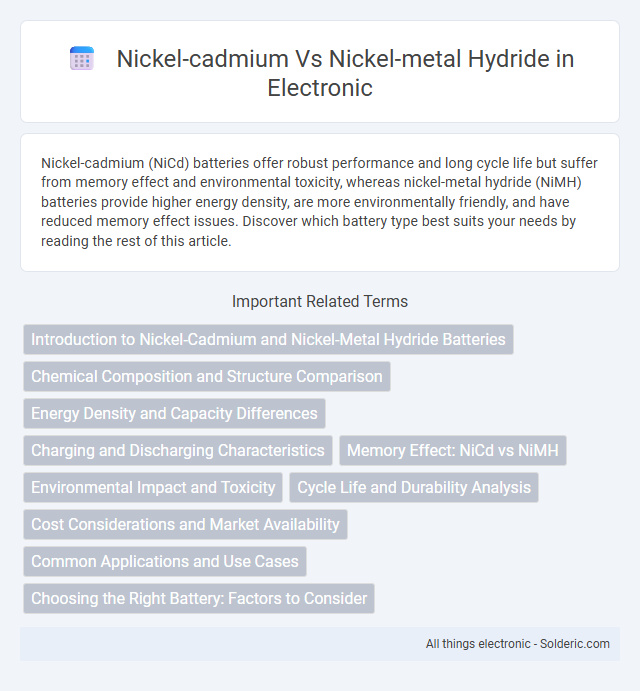Nickel-cadmium (NiCd) batteries offer robust performance and long cycle life but suffer from memory effect and environmental toxicity, whereas nickel-metal hydride (NiMH) batteries provide higher energy density, are more environmentally friendly, and have reduced memory effect issues. Discover which battery type best suits your needs by reading the rest of this article.
Comparison Table
| Feature | Nickel-Cadmium (NiCd) | Nickel-Metal Hydride (NiMH) |
|---|---|---|
| Energy Density | 45-80 Wh/kg | 60-120 Wh/kg |
| Memory Effect | Significant | Minimal |
| Self-Discharge Rate | 10% per month | 20-30% per month |
| Environmental Impact | Contains toxic Cadmium | Less toxic, more environmentally friendly |
| Cycle Life | 1000+ cycles | 500-1000 cycles |
| Charging Time | 1-3 hours | 2-4 hours |
| Cost | Lower | Higher |
| Typical Applications | Power tools, aviation, emergency systems | Digital cameras, hybrid vehicles, consumer electronics |
Introduction to Nickel-Cadmium and Nickel-Metal Hydride Batteries
Nickel-Cadmium (NiCd) and Nickel-Metal Hydride (NiMH) batteries are two prevalent rechargeable battery technologies widely used in portable electronics and power tools. NiCd batteries offer robust performance and high discharge rates but contain toxic cadmium, raising environmental concerns. NiMH batteries provide higher capacity and are more environmentally friendly due to the absence of heavy metals, making them suitable for applications demanding longer runtime and frequent recharging.
Chemical Composition and Structure Comparison
Nickel-cadmium (NiCd) batteries consist of nickel oxide hydroxide and metallic cadmium electrodes, with an alkaline potassium hydroxide electrolyte, offering a robust crystalline structure that withstands deep discharge. Nickel-metal hydride (NiMH) batteries use a hydrogen-absorbing alloy for the negative electrode and nickel oxyhydroxide for the positive electrode, creating a more complex metal hydride structure that enables higher capacity and energy density. The chemical composition of NiMH batteries allows for a more environmentally friendly profile due to the absence of toxic cadmium, and their metal hydride alloys exhibit improved charge retention and reduced memory effect compared to NiCd cells.
Energy Density and Capacity Differences
Nickel-metal hydride (NiMH) batteries typically offer higher energy density, ranging from 60 to 120 Wh/kg, compared to nickel-cadmium (NiCd) batteries, which provide around 45 to 80 Wh/kg. This results in NiMH cells having greater capacity and longer runtime for the same weight, making them more suitable for high-energy applications like digital cameras and electric vehicles. NiCd batteries, while having lower energy density, excel in durability and low-temperature performance, but their capacity is limited by memory effect and environmental concerns.
Charging and Discharging Characteristics
Nickel-cadmium (NiCd) batteries exhibit a robust charging ability with fast charge acceptance and a low self-discharge rate, making them suitable for applications requiring frequent cycling and rapid recharging. Nickel-metal hydride (NiMH) batteries, while offering higher capacity and reduced memory effect compared to NiCd, tend to have a higher self-discharge rate and require more precise charging control to prevent overheating and capacity loss. NiCd batteries maintain consistent voltage during discharge, whereas NiMH cells experience a slight voltage drop, influencing device performance under varying load conditions.
Memory Effect: NiCd vs NiMH
Nickel-cadmium (NiCd) batteries experience a significant memory effect, where repeated partial discharges reduce their maximum capacity, impacting long-term performance. Nickel-metal hydride (NiMH) batteries exhibit a much lower memory effect, allowing more flexible charging without substantial loss of capacity. Understanding this difference helps you choose the right battery type for devices requiring frequent recharging and optimal longevity.
Environmental Impact and Toxicity
Nickel-cadmium (NiCd) batteries contain toxic cadmium, a heavy metal that poses significant environmental hazards and requires careful disposal to prevent soil and water contamination. Nickel-metal hydride (NiMH) batteries offer a more eco-friendly alternative with lower toxicity and reduced environmental risks due to the absence of cadmium and the presence of less harmful materials. Recycling NiMH batteries is simpler and less costly, contributing to a smaller ecological footprint compared to NiCd batteries.
Cycle Life and Durability Analysis
Nickel-cadmium (NiCd) batteries typically offer around 1,000 to 1,500 charge-discharge cycles, exhibiting high durability and resistance to overcharging and deep discharges. Nickel-metal hydride (NiMH) batteries provide 500 to 1,000 cycles but generally offer higher energy density and reduced memory effect compared to NiCd. Despite NiMH's shorter cycle life, its environmental benefits and greater capacity make it preferable for applications prioritizing weight and runtime over maximum cycle durability.
Cost Considerations and Market Availability
Nickel-cadmium (NiCd) batteries generally have lower upfront costs but are becoming less available due to environmental regulations restricting cadmium use. Nickel-metal hydride (NiMH) batteries, despite higher initial costs, offer greater market availability and are favored for eco-friendly applications. The shift towards NiMH is driven by their better energy density and reduced environmental impact, influencing pricing and distribution trends.
Common Applications and Use Cases
Nickel-cadmium (NiCd) batteries are widely used in power tools, emergency lighting, and aviation due to their durability and ability to deliver high discharge rates. Nickel-metal hydride (NiMH) batteries are commonly found in consumer electronics, such as digital cameras and portable devices, because of their higher energy density and environmentally friendly composition. Choosing between NiCd and NiMH depends on your application's need for performance, longevity, and environmental impact.
Choosing the Right Battery: Factors to Consider
When choosing between Nickel-cadmium (NiCd) and Nickel-metal hydride (NiMH) batteries, consider energy density, memory effect, and environmental impact. NiMH batteries offer higher energy density and reduced memory effect, making them suitable for high-drain devices like cameras and cordless phones. NiCd batteries, while durable and able to perform well in low temperatures, contain toxic cadmium and have a stronger memory effect, posing environmental and performance trade-offs.
Nickel-cadmium vs Nickel-metal hydride Infographic

 solderic.com
solderic.com